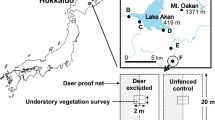Abstract
The early stage of forest regeneration on Miyajima Island, southewstern Japan, was studied for three years after a fire in 1984, with respect to the effects of deer browsing. The regeneration patterns of woody species, in terms of the biomass increment and browsing damage to plants, were classified into the following three groups: non- or rarely browsed species with little increment of biomass, heavily browsed with little increment, and heavily browsed with large increment. The aboveground biomass increased from 0.4 kg to 2.7 kg per 100 m2 during three years, and was less than half of the biomass obtained in other burnt pine forests on the adjacent deer-free islands. About 28% of the plant biomass was consumed by deer. The effects of browsing on forest regeneration were heavier at lower than that at the higher altitudes. On this island, deer browsing seems to have an important effect on vegetational succession in the burnt areas.
Similar content being viewed by others
References
Braun-Blanquet, J. (1964) Pflanzensoziologie. 3 Aufl. 865 pp. Springer, Wien.
Dickinson, K. J. M. &Kirkpatrick, J. B. (1986) The impact of grazing pressure in clearfelled, burned and undisturbed eucalypt forest. Vegetatio66: 133–136.
Doi, T., Inakazu, K., Ono, Y. &Kawahara, H. (1985) A preliminary study on the effects of sika deer on natural regeneration of forest. Bull. Nagasaki Inst. Appl. Sci.26: 13–18.
Crawley, J. M. (1983) Herbivory. The dynamics of animal-plant interactions. 437 pp. Univ. California Press, Berkeley.
Hytteborn, H., Packham, R. &Verwijst, T. (1987) Tree population dynamics, stand structure and species composition in the montane virgin forest of Vallibacken, northern Sweden, Vegetatio72: 3–19.
Hayashi, K. (1980) Proposition on the management of tamed sika deer (Cervus nippon) in Miyajima Island. Nature and Culture of Miyajima2: 22–33 (In Japanese).
Horikawa, Y. (1942) Ecological studies of Itsukushima Island. Ecol. Rev.8: 101–120 (In Japanese).
Linhart, Y. B. &Whelan, R. J. (1980) Woodland regeneration in relation to grazing and fencing in Coed Gorswen, North Wales. J. Appl. Ecol.17: 827–840.
Mallik, A. U. &Gimingham, C. H. (1983) Regeneration of heathland plants following burning. Vegetatio53: 45–58.
Nakagoshi, N., Nakane, K., Imaide, H. &Nehira, K. (1981) Regeneration of vegetation in the burned pine forest in southern Hiroshima Prefecture, Japan. I. Floristic composition, vegetation structure and biomass in the early stage of regeneration. Mem. Faculty of Integrated Arts and Sciences. Hiroshima Univ.6: 69–113 (In Japanese).
Nakagoshi, N. (1987) Post-fire succession of a pine forest in east Setouchi, Japan. “Papers on plant ecology and taxonomy to the memory of Dr. S. Nakanishi” (ed. Editorial board for the papers on plant ecology and taxonomy to the memory of Dr. S. Nakanishi), 383–392. The Kobe Geobotanical Soc., Kobe.
Nakane, K., Yakuta, K. &Nehira, K. (1986) Assessment of degree of the damage by forest fire based on Landsat MSS data: a case of the Miyajima Island, Hiroshima, Japan. J. Remote Sensing Soc. Jpn.6: 349–357.
Nakane, K. (1987) Importance of invasion and spread of the secondary vegetation following human disturbances on an ecosystem management. Res. J. Food Agric.10: 10–15 (In Japanese).
Nakane, K., Yamazaki, H., Nehira, K. &Fukuoka, Y. (1988) Studies on prevention of forest fire. (I) Control line of a fire. J. Jpn. For. Soc.70: 111–118 (In Japanese with English summary).
Okuda, T. (1984) Food habits of sika deer (Cervus nippon) and their ecological influence on the vegetation of Miyajima Island. Hikobia9: 93–102.
Peterken, G. F. &Tubbs, C. R. (1965) Woodland regeneration in New Forest, Hampshire, since 1650. J. Appl. Ecol.2: 159–170.
Pigott, C. D. (1983) Regeneration of oak-birch woodland following exclusion of sheep. J. Ecol.71: 629–646.
Seki, T., Nakanishi, H., Suzuki, H. &Horikawa, Y. (1975) A flora of vascular plants of Itsukushima (Miyajima) Island, southwestern Japan. “Scientific studies of Itsukushima Island” (ed. Horikawa, Y.), 221–332. Miyajima-chou, Hiroshima (In Japanese with English summary).
Shaw, M. W. (1968) Factors affecting the natural regeneration of sessile oak (Quercus petraea) in North Wales; II. Acron losses and germination under field conditions. J. Ecol.56: 647–660.
Suzuki, H., Toyohara, G., Jinno, N., Hukushima, T. &Ishibashi, N. (1975) The forest vegetation of Itsukushima (Miyajima) Island, S. W. Japan. “Scientific studies of Itsukushima Island” (ed. (Horikawa, Y.), 119–131. Miyajima-chou, Hiroshima (In Japanese with English summary).
Takahashi, K. (1986) Relationship of forest and fire. The Heredity (Iden)46: 22–26. (In Japanese).
Takatsuki, S. (1980) Ecological studies on effect of sika deer (Cervus nippon) on vegetation. II. The vegetation of Akune Island, Kagoshima Prefecture, with special reference to grazing and browsing effect of sika deer. Ecol. Rev.19: 123–144.
Takatsuki, S. (1982) Ecological studies on effect of sika deer (Cervus nippon) on vegetation. III. The vegetation of Iyo-Kashima Island, southwestern Shikoku, with reference to grazing effect of sika deer. Ecol. Rev.20: 15–29.
Takatsuki, S. (1983) Ecological studies on effect of sika deer (Cervus nippon) on vegetation. IV. Shimayama Island, the Goto Islands, Northwestern Kyushu. Ecol. Rev.20: 143–157.
Tokida, K., Maruyama, N., Itow, T., Furubayashi, K. &Abe H. (1980) Factors affecting the geographical distribution of sika deer. “Studies on wildlife distribution (Mammals)” (ed. Abe, Y.), 38–68. Japan Wildlife Research Center, Tokyo (In Japanese with English summary).
Toyohara, G. &Suzuki, H. (1975) A phytosociological study of pine forests in Itsukushima (Miyajima) Island and its neighboring areas of the mainland of Honshu. “Scientific studies of Itsukushima Island” (ed. Horikawa, Y.), 119–131. Miyajima-cho, Hiroshima (In Japanese with English summary).
Toyohara, G., Okuda, T., Fukushima, A. &Nishiura, H. (1986) Change of the vegetation after pine damage in Miyajima Island, Hiroshima. Jpn. J. Ecol.35: 609–619 (In Japanese with English summary).
Author information
Authors and Affiliations
About this article
Cite this article
Okuda, T., Nakane, K. Effects of deer browsing on the early stage of pyrogenic succession on Miyajima Island, southwestern Japan. Ecol. Res. 5, 353–366 (1990). https://doi.org/10.1007/BF02347010
Accepted:
Issue Date:
DOI: https://doi.org/10.1007/BF02347010




